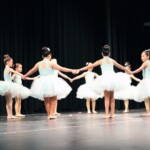Starting pointe work is a big step in a ballerina’s career. Knowing when to start pointe requires many factors. So how do you know when to start pointe or not to pointe? So here are some factors to consider whether or not to start pointe lessons.
The Appropriate Age For Pointe Classes
The suggested age to start pointe is around the age of 11 or 12. The reason age 11 or 12 is recommended instead of 9 or 10, is because the growth of the foot is complete around this age.
Starting Pointe to Early
There are many dangers to the student’s body if they start pointe lessons to early. Having a child start before they are ready to have less to do with actual bone or joint damage (although these are real) than with an inadequate range of motion, strength, and stability. These factors may cause undue stress on the leg, pelvic girdle, and trunk.
Years of Training
To start pointe it is recommended to at least have 3 years of training in ballet, having more years of training is an advantage if you are looking to start pointe. It is also recommended to be enrolled in at least 3 ballet classes before starting pointe. Here at Omaha School of Music and Dance in Omaha, NE we offer Pathway to Pointe which is a starting class for pointe. It is recommended to be here at OSMD to be here for 1 yr and be in at least 1 ballet class, and to have the okay from at least 2 of our instructors here at OSMD.
Physically and Emotionally Prepared
If you are debating whether to start Pointe consider if you want to put the time and commitment. To start pointe your ballet instructor has to determine if you are physically ready.
Some things your instructor will check for are:
- Correct body position and alignment
- Sufficient turnout
- Strength and Balance
- Mastery of basic ballet technique
- Shows awareness of proper ankle and foot alignment, avoiding sickling or rolling.
- Effectively uses pile while dancing
- Stretches or point the foot or rolling in.
- Can perform repeated relevé in the center without tiring & while maintaining alignment
- Can balance one foot with the body correctly positioned over for supporting leg
- Coordinate movements well, particularly in regard to the varying approach to relevé (from plié, from the straight leg, stepping or springing into, etc.)
Bone Structure
The structure of the student’s ankle and the foot is of great importance. The ideal foot has toes of nearly equal length which provide a “squared-off” platform on which to stand. Students having a long big toe may experience some difficulty and discomfort on pointe since the entire body weight must be supported on just the big toes, but this type of foot does not necessarily prevent the dancer from dancing well, safely, or relatively pain-free.
Injuries To Be Aware Of
- Toe misalignment is often avoided by adjusting toe alignments with gel toe spacers.
- Toenail bruising can be caused by heavy pressure on the surface of the nail. This is typically prevented by keeping toenails clipped short, by wrapping the tape around the toes, by using padding, or combinations of these.
- Bruising can also occur on the tips of the toes, especially when no padding is used. It is highly unadvised to dance en pointe without any padding at all.
- Other exterior injuries include cuts caused by toenails piercing adjacent toes. This can be prevented by keeping toenails cut short and filed smooth.
- Calluses may form on the bottoms and sides of the feet, which can crack open. This can be helped by the use of gel pad protectors on specific problem spots or using pads to surround the toes.
- Ingrown toenails can result from ill-fitting shoes.
Pointe takes a lot of commitment, you will suffer a lot of sore feet and occasional blisters. Pointe shoes are complicated and you must be fit and taught the correct way to put them on. You must be patient to be successful when starting off in pointe.
If you are interested in ballet classes please give us a call at (402) 515-9639 or Contact Us Today for more information. Register Today!



